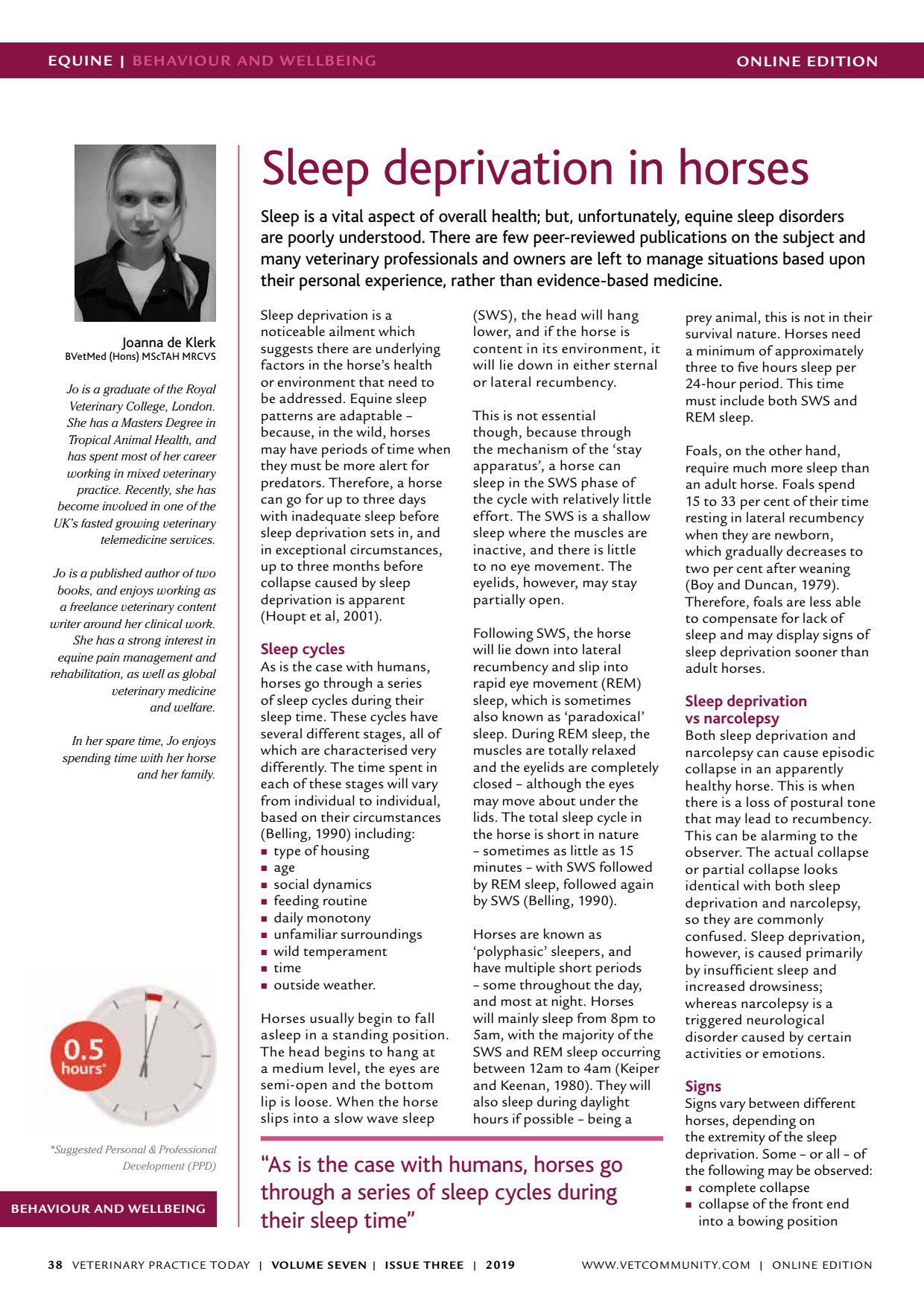Sleep deprivation horses
ONLINE EDITIONEQUINE | BEHAVIOUR AND WELLBEING VETERINARY PRACTICE TODAY | VOLUME SEVEN | ISSUE THREE | 2019 38 BEHAVIOUR AND WELLBEING Suggested Personal & Professional Development (PPD) Joanna de Klerk BVetMed (Hons) MScTAH MRCVS Jo is a graduate of the Royal Veterinary College, London. She has a Masters Degree in Tropical Animal Health, and has spent most of her career working in mixed veterinary practice. Recently, she has become involved in one of the UKs fasted growing veterinary telemedicine services. Jo is a published author of two books, and enjoys working as a freelance veterinary content writer around her clinical work. She has a strong interest in equine pain management and rehabilitation, as well as global veterinary medicine and welfare. In her spare time, Jo enjoys spending time with her horse and her family. Sleep deprivation in horses Sleep is a vital aspect of overall health; but, unfortunately, equine sleep disorders are poorly understood. There are few peer-reviewed publications on the subject and many veterinary professionals and owners are left to manage situations based upon their personal experience, rather than evidence-based medicine. Sleep deprivation is a noticeable ailment which suggests there are underlying factors in the horses health or environment that need to be addressed. Equine sleep patterns are adaptable because, in the wild, horses may have periods of time when they must be more alert for predators. Therefore, a horse can go for up to three days with inadequate sleep before sleep deprivation sets in, and in exceptional circumstances, up to three months before collapse caused by sleep deprivation is apparent (Houpt et al, 2001). Sleep cycles As is the case with humans, horses go through a series of sleep cycles during their sleep time. These cycles have several different stages, all of which are characterised very differently. The time spent in each of these stages will vary from individual to individual, based on their circumstances (Belling, 1990) including: type of housing age social dynamics feeding routine daily monotony unfamiliar surroundings wild temperament time outside weather. Horses usually begin to fall asleep in a standing position. The head begins to hang at a medium level, the eyes are semi-open and the bottom lip is loose. When the horse slips into a slow wave sleep (SWS), the head will hang lower, and if the horse is content in its environment, it will lie down in either sternal or lateral recumbency. This is not essential though, because through the mechanism of the stay apparatus, a horse can sleep in the SWS phase of the cycle with relatively little effort. The SWS is a shallow sleep where the muscles are inactive, and there is little to no eye movement. The eyelids, however, may stay partially open. Following SWS, the horse will lie down into lateral recumbency and slip into rapid eye movement (REM) sleep, which is sometimes also known as paradoxical sleep. During REM sleep, the muscles are totally relaxed and the eyelids are completely closed although the eyes may move about under the lids. The total sleep cycle in the horse is short in nature sometimes as little as 15 minutes with SWS followed by REM sleep, followed again by SWS (Belling, 1990). Horses are known as polyphasic sleepers, and have multiple short periods some throughout the day, and most at night. Horses will mainly sleep from 8pm to 5am, with the majority of the SWS and REM sleep occurring between 12am to 4am (Keiper and Keenan, 1980). They will also sleep during daylight hours if possible being a prey animal, this is not in their survival nature. Horses need a minimum of approximately three to five hours sleep per 24-hour period. This time must include both SWS and REM sleep. Foals, on the other hand, require much more sleep than an adult horse. Foals spend 15 to 33 per cent of their time resting in lateral recumbency when they are newborn, which gradually decreases to two per cent after weaning (Boy and Duncan, 1979). Therefore, foals are less able to compensate for lack of sleep and may display signs of sleep deprivation sooner than adult horses. Sleep deprivation vs narcolepsy Both sleep deprivation and narcolepsy can cause episodic collapse in an apparently healthy horse. This is when there is a loss of postural tone that may lead to recumbency. This can be alarming to the observer. The actual collapse or partial collapse looks identical with both sleep deprivation and narcolepsy, so they are commonly confused. Sleep deprivation, however, is caused primarily by insufficient sleep and increased drowsiness; whereas narcolepsy is a triggered neurological disorder caused by certain activities or emotions. Signs Signs vary between different horses, depending on the extremity of the sleep deprivation. Some or all of the following may be observed: complete collapse collapse of the front end into a bowing position As is the case with humans, horses go through a series of sleep cycles during their sleep time WWW.VETCOMMUNIT Y.COM | ONLINE EDITION
